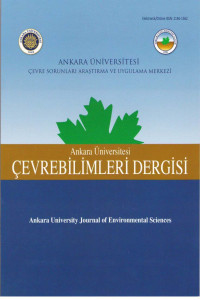Ağ kafeslerde sürdürülebilir balık yetiştiriciliği için bir bilgisayar yazılımının kullanımı
Son yıllarda tüm dünyada ağ kafeslerde entansif balık yetiştiriciliğinin artış göstermesi, yetiştiriciliğin çevresel etkileri konusunda da bilinçlenmenin artmasına ve sürdürülebilir yetiştiricilik kavramının önem kazanmasına neden olmuştur. Bu duruma paralel olarak yetiştiriciliğin çevresel etkilerine ilişkin yeni modeller bulunmakta veya var olan modeller gelişen teknoloji ve yetiştiricilik yöntemlerine göre kalibre edilmektedir. Çevre ile dost yetiştiricilik yapabilmek için kısa zamanda güvenilir sonuç verebilecek teknolojik yaklaşımları içeren model uygulamalarına gereksinim duyulmaktadır. Bu çalışmada, ağ kafeslerde sürdürülebilir yetiştiricilik için geliştirilen ve -Ağ Kafeslerde Yetiştiriciliğe İlişkin Karar Destek Sistemikısaca CADS_TOOL olarak adlandırılan bilgisayar yazılımı sunulmuştur. Bilgisayar yazılımı; alan sınıflandırması, alan seçimi, ağ kafeslerde taşıma yoğunluğu (kg/m3) - alıcı ortamın taşıma kapasitesinin tahmini ile işletmelerin ekonomik açıdan değerlendirilmeleri şeklindeki dört modülü kapsamaktadır. Bu dört modülü oluşturan kriterlerin, ağ kafeslerde balık yetiştiriciliği yapan işletmeler için saha ve laboratuar çalışmalarından elde edilecek veriler doğrultusunda belirlenmesi gereklidir. Çalışma kapsamında kullanımı önerilen yazılımın, hızlı ve kolay uygulanabilir olması nedeniyle, Türkiye’de farklı sucul ekosistemlerde dağılım gösteren ağ kafes işletmelerinin yönetimi ve yetiştiriciliğin çevresel etkilerinin izlenmesi konusunda
Anahtar Kelimeler:
Ağ kafeslerde balık yetiştiriciliği, Taşıma kapasitesi, Bilgisayar yazılımı.
Using of the Computer Software for the Sustainable Fish Cage Culture
In the recent years, a world-wide substantial increase in the intensive aquaculture caused an increase of awareness in the environmental impacts of fish farming and sustainable farming to become important. So, for the effect of the cage aquaculture, new models are developing or existent models are calibrating with the new technological and culture techniques. There’s a necessity of a model –eco-friendly aquaculture- which can give reliable results in a short time and has technological information about cage aquaculture for the sustainable farming. In this study, application of a decision support system for the sustainable cage aquaculture developing programme –shortly CADS_TOOL- is presented. The programme has four modules; site classification, site selection, holding density (kg m-3)- carrying capacity and economical apprasial. The program’s criteria must be determined for the cage farms in line with the results of the field and laboratory analysis. The programme proposed in this study, is fast and easily applicable, and thought to play a key role in the subject of the management of different cage farms in distinct aquatic ecological areas and monitoring of the environmental impacts of fish farming in Turkey
Keywords:
Cage culture, Carrying capacity, Computer software,
___
- Ackefors, H. and Enell, M. 1990. Discharge of Nutriens from Swedish Fish Farming to Adjacent Sea Areas. Ambio, 19: 29- 35.
- Alpaslan, A. and Pulatsü, S. 2008. The Effect of Rainbow Trout (Oncorhynchus mykiss Walbaum, 1792) Cage Culture on Sediment Quality in Kesikköprü Reservoir, Turkey. Turkish Journal of Fisheries and Aquatic Sciences, 8 (1): 65- 70.
- Demir, N., Kırkağaç, M., Pulatsü, S. and Bekcan, S. 2001. Influence of Trout Cage Culture on Water Quality, Plankton and
- Benthos in an Anatolian Dam Lake. The Israeli Journal of Aquaculture-Bamidgeh, 53 (3-4): 115-127.
- Dillon, P.J.and Rigler, F.H. 1974. A Test of a Simple Nutrient Budget Model Predicting the Phosphorus Concentration in
- Lake Water. J. Fish.Res.Board Can., 31: 1771-1778.
- Ervik A., Hansen, P.K., Aure, J., Stigebrandt, A., Johannessen, P. and Jahnsen, T.1997. Regulating the Local Environment Impact of Intensive Marine Fish Farming I. The Concept of the MOM System (Modelling-Ongrowing fish farms- Monitoring). Aquaculture, 158, 85-94.
- Halide, H., Stigebrandt, A., Rehbein, M. and McKinnon, A.D. 2009. Developing a Decision Support System for Sustainable
- Cage Aquaculture. Environmental Modelling&Software, 24, 694-702.
- Hansen, P.K., Ervik, A., Schaanning, M., Johannessen, P., Aure, J., Jahnsen, T. and Stigebrandt A. 2001. Regulating the Local Environment Impact of Intensive Marine Fish Farming II. The Monitoring Programme of the MOM System (Modelling-Ongrowing fish farms- Monitoring). Aquaculture, 194, 75-92.
- Pulatsü, S. 2003. The Application of Phosphorus Budget Model Estimating the Carrying Capacity of Kesikköprü Dam Lake. Turkish Journal of Veterinary and Animal Sciences, 27(5): 1127-1130.
- Stigebrandt, A., Aure, J., Ervik, A. and Hansen, P.K. 2004. Regulating the Local Environment Impact of Intensive Marine Fish Farming III. A Model for Estimation of the Holding Capacity in the Modelling-Ongrowing Fish Farms- Monitoring System. Aquaculture, 234, 239-261.
- Yavuzcan, H., Pulatsü, S., Demir, N., Kırkağaç, M., Bekcan, S., Topçu, A., Doğankaya, L., ve Başçınar, N. 2010. Türkiye’de Sürdürülebilir Su Ürünleri Yetiştiriciliği. TMMOB Ziraat Mühendisliği VII. Teknik Kongresi Bildiriler Kitabı: 767- 789, 11-15 Ocak 2010, Ankara.
- Yayın Aralığı: Yılda 2 Sayı
- Başlangıç: 2009
- Yayıncı: Ankara Üniversitesi
